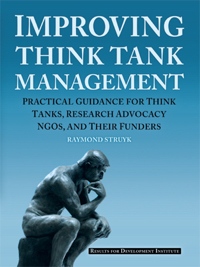There are a lot of things they don’t teach you in graduate school: how to prepare a budget, how to woo a donor, how to ease an unproductive colleague off the payroll without incurring his or her wrath. And a whole lot of other skills that are required to do a good job as a leader of a think tank or other research institution. There are, in fact, few opportunities to gain that know-how except through trial-and-error.
When people who have had distinguished careers as researchers move into executive roles – a path that’s common in think tanks – they’re often entering the foreign territory of management, organizational finance and operations. Deliberation and on-the-one-hand-on-the-other-hand analysis have to give way to making decisions and sticking with them. A love of ideas and discourse has to take a back seat to practical matters: Who gets which office? Should we take government contracts? How do we set and defend an indirect cost rate? How do we maintain an independent research agenda if most of our money is tied to funders’ specific interests? These may not be as fun to puzzle through as questions about the effects of a new tax regime on unemployment, but they’re essential to the health and sustainability of an organization.
Fortunately, think tank leaders have a new resource to help them learn the ropes, building on others’ hard-won experience. They can find valuable advice and tools in Improving Think Tank Management: Practical Guidance for Think Tanks, Research Advocacy Organizations and Their Funders, just launched by Results for Development. With our support, the author, Ray Struyk, dug into his decades of experience helping to set up think tanks, and created a go-to source of guidance on key issues related to staffing, funding and running a policy research organization. He also drew on information and case studies from the Global Development Network, the Think Tank Fund and the Think Tank Initiative, making the book relevant to organizations in every region. The freely available checklists, sample by-laws and policies, and other ancillary information that go with each chapter help translate the ideas into action. As a bonus, the book includes specific guidance for think tank funders about how to assess and support policy research groups. (In my copy, those pages are already dog-eared.)
Improving Think Tank Management, written for a niche market, isn’t likely to make it to the best seller list. But for the men and women who bear the weight of their organization’s success on their shoulders, I guarantee it will be a page-turner – and will make it just that much more likely that they’ll be able to build the great think tanks that the world needs.



